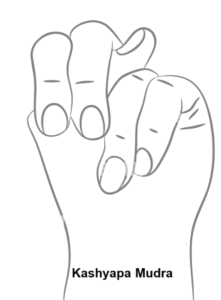Kashyapa Mudrā
Introduction
Kashyapa Mudrā is a symbolic and therapeutic hand gesture found in yoga, Ayurveda, and mudra therapy. It is named after the ancient sage Kashyapa, considered a progenitor of humanity and a revered teacher in Indian tradition. In yogic practice, this mudra is associated with balancing internal energies, removing inner conflicts, and restoring harmony between mind and body.
Unlike dance mudras, Kashyapa Mudra is more commonly practiced in mudra therapy and meditation, and it is sometimes called the “Tortoise Mudra” or “Harmony Mudra.”
Meaning
The name Kashyapa refers to the sage known for his wisdom, balance, and calm presence.
Symbolically, this mudra means holding harmony within oneself, uniting opposites like light and dark, male and female, sun and moon.
It is often interpreted as a mudra for inner balance, detoxification, and grounding.
How to Perform Practice
Sit in a comfortable meditative posture such as Padmasana, Vajrasana, or Sukhasana.
Place the tip of the thumb in the web between the middle and ring fingers.
Close the remaining fingers as if making a fist.
Close your eyes, breathe deeply, and hold the mudra for several minutes.
Focus on balance and inner harmony while practicing.
Benefits of Kashyapa Mudrā
Physical Benefits
Improves digestion and assimilation of nutrients.
Stimulates immune system function and strengthens resistance to infections.
Helps in relieving allergic reactions and respiratory problems.
Aids in detoxification of liver and spleen.
Mental Benefits
Promotes emotional balance and reduces inner conflicts.
Relieves stress, anxiety, and mood swings.
Enhances clarity and self-awareness.
Brings a sense of peace and neutrality.
Spiritual Benefits
Encourages a state of equanimity (samatvam).
Assists in balancing the Ida (moon/feminine) and Pingala (sun/masculine) nadis.
Supports meditation by stabilizing energy flow.
Symbolizes union of opposites, leading to wholeness.
Contraindications
Should not be practiced excessively (over 45 minutes daily).
Avoid if experiencing acute joint inflammation in the fingers.
People with low blood pressure should practice moderately, as it has a calming effect.
Anatomy & Physiology
Activates hand acupressure points linked to the liver, spleen, and lungs.
Stimulates the parasympathetic nervous system (rest-and-digest).
Improves circulation in thoracic and abdominal regions.
Supports the lymphatic system in clearing toxins.
Kinesiology
Engages the flexor muscles of the fingers, primarily the flexor digitorum superficialis and profundus.
The folding of the index finger over the thumb creates muscular stability and symbolic “containment.”
Helps train fine motor control and neuromuscular balance in the hand.
Neurology
Crossing of index finger over thumb stimulates bilateral cortical activity.
Activates somatosensory regions linked to touch and proprioception.
Promotes calmness by engaging the vagus nerve pathway, reducing sympathetic overdrive.
Improves mind-body connection through steady hand positioning.
Duration of Mudra
Therapeutic use: 15–30 minutes daily (can be split into 2–3 sessions).
Meditation: 10–15 minutes for grounding and balance.
Chronic conditions (like allergies): Regular practice for several weeks recommended.
Counter Mudra
To balance or release the effects of Kashyapa Mudra:
Apana Mudra (for purification and grounding).
Chin Mudra (for energy upliftment and awareness).
Prana Mudra (for vitality and immune boost).
Conclusion
Kashyapa Mudrā is a powerful gesture symbolizing balance, harmony, and detoxification. Physically, it supports digestion, immunity, and respiratory health; mentally, it reduces stress and brings emotional clarity; spiritually, it unites dualities and supports meditation. Named after Sage Kashyapa, it reflects wisdom and equilibrium. When practiced regularly and mindfully, it becomes a tool for healing, grounding, and inner peace.
FAQ
Q1. What is Kashyapa Mudra good for?
It is excellent for allergies, immunity boosting, detoxification, and balancing emotions.
Q2. Can I practice it during meditation?
Yes, it is often used to bring mental balance and stability during meditation.
Q3. Which chakra does it influence?
Primarily the Solar Plexus (Manipura Chakra) for balance and the Heart Chakra (Anahata) for harmony.
Q4. Is it safe for beginners?
Yes, it is easy and safe for all age groups if practiced gently.
Q5. How long before benefits are noticed?
Benefits may be felt within 2–3 weeks of regular practice.
References
Swami Satyananda Saraswati, Asana, Pranayama, Mudra, Bandha.
Gertrud Hirschi, Mudras: Yoga in Your Hands.
Joseph Le Page & Lilian Aboim, Mudras for Healing and Transformation.
Rajeswari Raman, Mudras: For Body, Mind and Spirit.
Ayurveda and Yoga texts referring to Sage Kashyapa and symbolic mudras.
